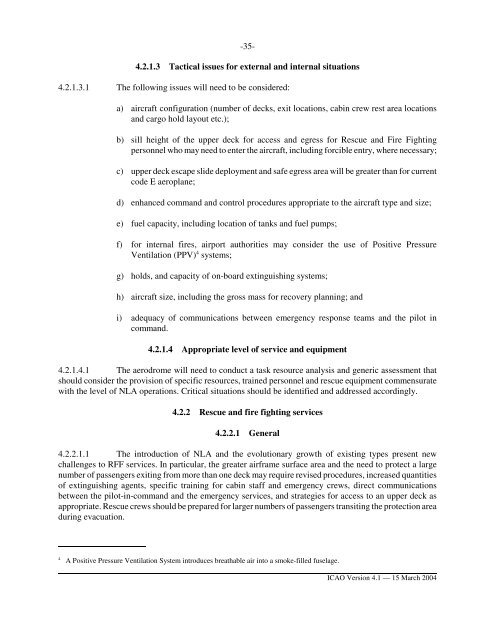Draft ICAO Circular on NLA.pdf - Airports Council International
Draft ICAO Circular on NLA.pdf - Airports Council International
Draft ICAO Circular on NLA.pdf - Airports Council International
You also want an ePaper? Increase the reach of your titles
YUMPU automatically turns print PDFs into web optimized ePapers that Google loves.
-35-<br />
4.2.1.3 Tactical issues for external and internal situati<strong>on</strong>s<br />
4.2.1.3.1 The following issues will need to be c<strong>on</strong>sidered:<br />
a) aircraft c<strong>on</strong>figurati<strong>on</strong> (number of decks, exit locati<strong>on</strong>s, cabin crew rest area locati<strong>on</strong>s<br />
and cargo hold layout etc.);<br />
b) sill height of the upper deck for access and egress for Rescue and Fire Fighting<br />
pers<strong>on</strong>nel who may need to enter the aircraft, including forcible entry, where necessary;<br />
c) upper deck escape slide deployment and safe egress area will be greater than for current<br />
code E aeroplane;<br />
d) enhanced command and c<strong>on</strong>trol procedures appropriate to the aircraft type and size;<br />
e) fuel capacity, including locati<strong>on</strong> of tanks and fuel pumps;<br />
f) for internal fires, airport authorities may c<strong>on</strong>sider the use of Positive Pressure<br />
Ventilati<strong>on</strong> (PPV) 4 systems;<br />
g) holds, and capacity of <strong>on</strong>-board extinguishing systems;<br />
h) aircraft size, including the gross mass for recovery planning; and<br />
i) adequacy of communicati<strong>on</strong>s between emergency resp<strong>on</strong>se teams and the pilot in<br />
command.<br />
4.2.1.4 Appropriate level of service and equipment<br />
4.2.1.4.1 The aerodrome will need to c<strong>on</strong>duct a task resource analysis and generic assessment that<br />
should c<strong>on</strong>sider the provisi<strong>on</strong> of specific resources, trained pers<strong>on</strong>nel and rescue equipment commensurate<br />
with the level of <strong>NLA</strong> operati<strong>on</strong>s. Critical situati<strong>on</strong>s should be identified and addressed accordingly.<br />
4.2.2 Rescue and fire fighting services<br />
4.2.2.1 General<br />
4.2.2.1.1 The introducti<strong>on</strong> of <strong>NLA</strong> and the evoluti<strong>on</strong>ary growth of existing types present new<br />
challenges to RFF services. In particular, the greater airframe surface area and the need to protect a large<br />
number of passengers exiting from more than <strong>on</strong>e deck may require revised procedures, increased quantities<br />
of extinguishing agents, specific training for cabin staff and emergency crews, direct communicati<strong>on</strong>s<br />
between the pilot-in-command and the emergency services, and strategies for access to an upper deck as<br />
appropriate. Rescue crews should be prepared for larger numbers of passengers transiting the protecti<strong>on</strong> area<br />
during evacuati<strong>on</strong>.<br />
4 A Positive Pressure Ventilati<strong>on</strong> System introduces breathable air into a smoke-filled fuselage.<br />
<str<strong>on</strong>g>ICAO</str<strong>on</strong>g> Versi<strong>on</strong> 4.1 — 15 March 2004

















